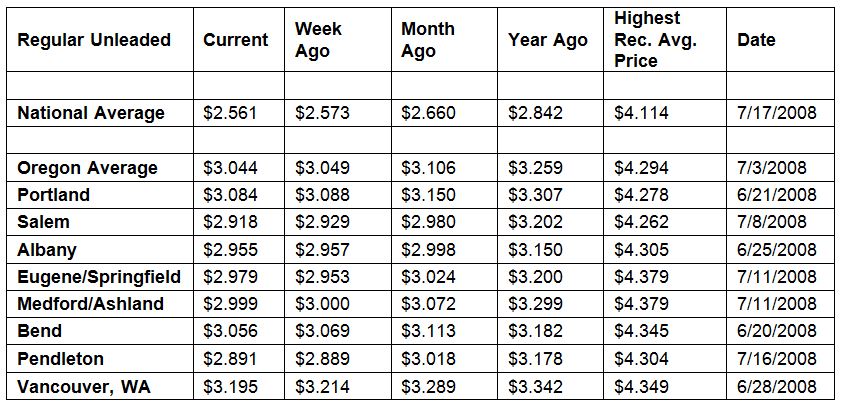PORTLAND, Ore., – Retail gas prices continue to slowly and steadily decline as the summer driving season comes to an end. For the week, the national average for regular falls a penny to $2.56 a gallon. The Oregon average slips half a cent to $3.04.
“Demand for gasoline and gasoline stocks usually drop in early September as refineries undergo maintenance and get ready for the switchover to winter-blend gasoline. This usually translates into cheaper pump prices which normally last through the end of the year,” says Marie Dodds, public affairs director for AAA Oregon/Idaho. “Currently all state averages are about 20 to 53 cents cheaper than a year ago.”
The latest report from the U.S. Energy Information Administration (EIA) shows that U.S. gasoline demand saw a steady decline from 9.9 million b/d to 9.4 million b/d, a reading typical for this time of year. In addition to the drop in demand, EIA data also shows that domestic gasoline stocks fell by 2 million bbl, which is mostly attributed to exports.
Oregon is one of 35 states and the District of Columbia where prices are lower now than a week ago. Ohio (-8 cents) has the largest weekly drop. Indiana (+7 cents) has the largest weekly increase. This week there are five states with an average above $3 a gallon, same as a week ago.
Oregon is one of 48 states and the District of Columbia with lower prices now than a month ago. The national average is 10 cents less and the Oregon average is six cents less than a month ago. This is the 41st-largest monthly decline in the nation. The District of Columbia (-19 cents) has the largest month-over-month decline. Arizona (+5 cents) and Hawaii (+1/2 cent) are the only states with monthly increases.
Drivers in 49 states and the District of Columbia are paying less than a year ago. The national average is 28 cents less and the Oregon average is 22 cents less than a year ago. Delaware (-53 cents) has the largest year-over-year drop.
The West Coast continues to have the highest pump prices in the nation with all of the region’s states landing on the top 10 most expensive list.
| Rank | Region | Price on 9/10/19 | |
| 1 | Hawaii | $3.66 | |
| 2 | California | $3.63 | |
| 3 | Washington | $3.20 | |
| 4 | Nevada | $3.11 | |
| 5 | Oregon | $3.04 | |
| 6 | Alaska | $2.96 | |
| 7 | Arizona | $2.83 | |
| 8 | Utah | $2.79 | |
| 9 | Idaho | $2.77 | |
| 10 | New York | $2.74 |
Hawaii is most expensive for the fifth week in a row with California, Washington, Nevada, Oregon, Alaska and Arizona rounding out the top seven. Oregon is fifth most expensive for the eighth week in a row.
Most state averages in the region have decreased on the week except for California and Arizona which each saw increases of half a cent.
The EIA’s recent report for the week ending on Aug. 30 showed that West Coast gasoline stocks decreased by 600,000 bbl. The total level is now 28.4 million bbl, which is in line with stock levels at the end of August 2018. Prices in the region will likely decline this week.
The cheapest gas in the nation can be found in Mississippi ($2.18) and Louisiana ($2.19). For the 30th week in a row, no states have an average below $2 a gallon.
Oil market dynamics
Domestic crude prices rose last week after the EIA reported that total domestic crude inventories fell by 4.8 million bbl. At 423 million bbl, stocks are approximately 21.5 million bbl higher than were they were at the end of August 2018. Higher inventory levels have helped to keep oil cheaper this year over last, but if EIA’s report this week shows that stocks continue to shrink, prices could end the week higher again. Alternatively, if ongoing trade tensions between the U.S. and China escalate, crude prices could fall.
At the close of Friday’s formal trading session on the NYMEX, WTI increased by 22 cents to settle at $56.52. At the close of Monday’s formal trading session on the NYMEX, WTI gained $1.33 to close at $57.85. Today crude is trading around $58, compared to $54 a week ago. Crude prices are up about five percent in the last month and are about $10 per barrel less than a year ago.
Drivers can find current gas prices along their route with the free AAA Mobile app for iPhone, iPad and Android. The app can also be used to map a route, find discounts, book a hotel and access AAA roadside assistance. Learn more at AAA.com/mobile.
Diesel
For the week, the national average slips a penny to $2.92 a gallon. Oregon’s average holds steady at $3.12. A year ago the national average for diesel was $3.18 and the Oregon average was $3.39.
Find current fuel prices at GasPrices.AAA.com.
AAA news releases, high resolution images, broadcast-quality video, fact sheets and podcasts are available on the AAA NewsRoom at NewsRoom.AAA.com.
Find local news releases at https://www.oregon.aaa.com/category/news-releases/



